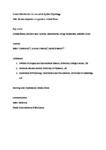Human adaptation to hypoxia in critical illness
| dc.contributor.author | McKenna, HT | |
| dc.contributor.author | Murray, AJ | |
| dc.contributor.author | Martin, DS | |
| dc.date.accessioned | 2021-08-10T07:40:22Z | |
| dc.date.available | 2021-08-10T07:40:22Z | |
| dc.date.issued | 2020-10-01 | |
| dc.identifier.issn | 8750-7587 | |
| dc.identifier.issn | 1522-1601 | |
| dc.identifier.uri | http://hdl.handle.net/10026.1/17533 | |
| dc.description.abstract |
<jats:p>The syndrome of critical illness is a complex physiological stressor that can be triggered by diverse pathologies. It is widely believed that organ dysfunction and death result from bioenergetic failure caused by inadequate cellular oxygen supply. Teleologically, life has evolved to survive in the face of stressors by undergoing a suite of adaptive changes. Adaptation not only comprises alterations in systemic physiology but also involves molecular reprogramming within cells. The concept of cellular adaptation in critically ill patients is a matter of contention in part because medical interventions mask underlying physiology, creating the artificial construct of “chronic critical illness,” without which death would be imminent. Thus far, the intensive care armamentarium has not targeted cellular metabolism to preserve a temporary equilibrium but instead attempts to normalize global oxygen and substrate delivery. Here, we review adaptations to hypoxia that have been demonstrated in cellular models and in human conditions associated with hypoxia, including the hypobaric hypoxia of high altitude, the intrauterine low-oxygen environment, and adult myocardial hibernation. Common features include upregulation of glycolytic ATP production, enhancement of respiratory efficiency, downregulation of mitochondrial density, and suppression of energy-consuming processes. We argue that these innate cellular adaptations to hypoxia represent potential avenues for intervention that have thus far remained untapped by intensive care medicine.</jats:p> | |
| dc.format.extent | 656-663 | |
| dc.format.medium | Print-Electronic | |
| dc.language | en | |
| dc.language.iso | en | |
| dc.publisher | American Physiological Society | |
| dc.subject | critical illness | |
| dc.subject | energy metabolism | |
| dc.subject | hypoxia | |
| dc.subject | intensive care | |
| dc.subject | mitochondria | |
| dc.subject | oxidative stress | |
| dc.title | Human adaptation to hypoxia in critical illness | |
| dc.type | journal-article | |
| dc.type | Review | |
| plymouth.author-url | https://www.ncbi.nlm.nih.gov/pubmed/32853113 | |
| plymouth.issue | 4 | |
| plymouth.volume | 129 | |
| plymouth.publication-status | Published | |
| plymouth.journal | Journal of Applied Physiology | |
| dc.identifier.doi | 10.1152/japplphysiol.00818.2019 | |
| plymouth.organisational-group | /Plymouth | |
| plymouth.organisational-group | /Plymouth/Faculty of Health | |
| plymouth.organisational-group | /Plymouth/Faculty of Health/Peninsula Medical School | |
| plymouth.organisational-group | /Plymouth/REF 2021 Researchers by UoA | |
| plymouth.organisational-group | /Plymouth/REF 2021 Researchers by UoA/UoA01 Clinical Medicine | |
| plymouth.organisational-group | /Plymouth/Users by role | |
| plymouth.organisational-group | /Plymouth/Users by role/Academics | |
| plymouth.organisational-group | /Plymouth/Users by role/Researchers in ResearchFish submission | |
| dc.publisher.place | United States | |
| dcterms.dateAccepted | 2020-08-19 | |
| dc.rights.embargodate | 2021-9-28 | |
| dc.identifier.eissn | 1522-1601 | |
| dc.rights.embargoperiod | Not known | |
| rioxxterms.versionofrecord | 10.1152/japplphysiol.00818.2019 | |
| rioxxterms.licenseref.uri | http://www.rioxx.net/licenses/all-rights-reserved | |
| rioxxterms.licenseref.startdate | 2020-10-01 | |
| rioxxterms.type | Journal Article/Review |


